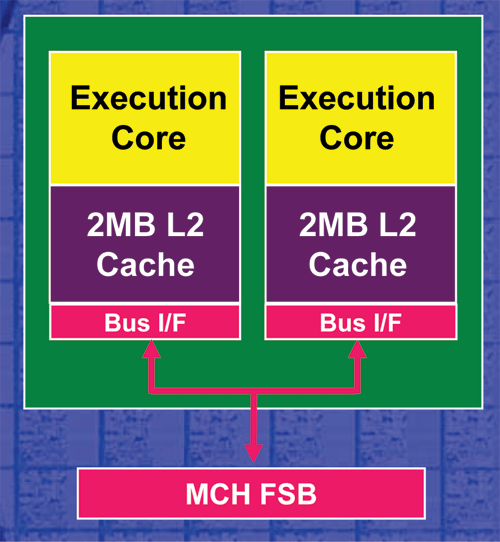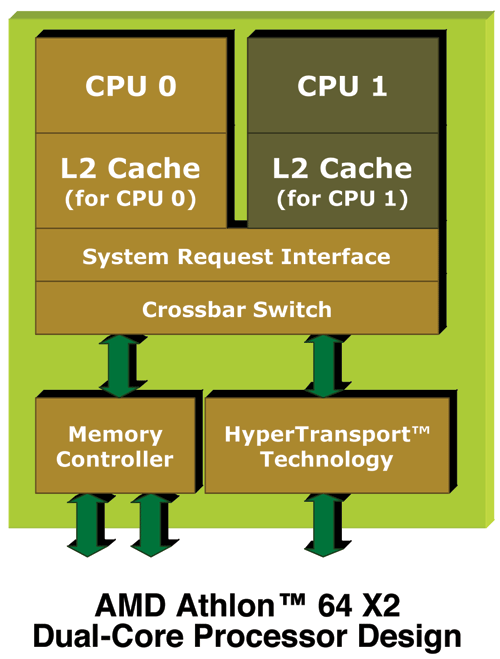AMD's dual core Opteron & Athlon 64 X2 - Server/Desktop Performance Preview
by Anand Lal Shimpi, Jason Clark & Ross Whitehead on April 21, 2005 9:25 AM EST- Posted in
- CPUs
A Look at AMD's Dual Core Architecture
Even Intel will admit that the architecture of the Pentium D is not the most desirable as is two Pentium 4 cores literally glued together. The two cores can barely be managed independently from a power consumption standpoint (they still share the same voltage and must run in the same power state) and all communication between cores must go over the external FSB. The diagram below should illustrate the latter point pretty well:
Intel's Pentium D dual core architecture
AMD's architecture is much more sophisticated, thanks to the K8 architecture's on-die North Bridge. While we normally only discuss the benefits of the K8's on-die memory controller, the on-die North Bridge is extremely important for dual core. Instead of having all communication between the cores go over an external FSB, each core will put its request on the System Request Queue (SRQ) and when resources are available, the request will be sent to the appropriate execution core - all without leaving the confines of the CPU's die. There are numerous benefits to AMD's implementation, and in heavily multithreaded/multitasking scenarios, it is possible for AMD to have a performance advantage over Intel just because of this implementation detail alone.

AMD's solution to the problem will come in the form of DDR2 and a new socket down the road, but for now there's no getting around the memory bandwidth limitations. Intel is actually in a better position from a memory bandwidth standpoint. At this point, their chipsets provide more memory bandwidth than what a single core needs with their dual channel DDR2-667 controller. The problem is that the Intel dual core CPUs still run on a 64-bit wide 800MHz FSB, which makes Intel's problem more of a FSB bandwidth limitation than a memory bandwidth limitation.
Backwards Compatibility
Intel's dual core Pentium D and Extreme Edition won't work in any previous motherboards, but as we mentioned at the start of this article, AMD has more bang. Here, the additional bang comes from the almost 100% backwards compatibility with single-core motherboards. We say "almost" because it's not totally perfect; here's the breakdown:- On the desktop, the Athlon 64 X2 series is fully compatible with all Socket-939 motherboards. All you need is a BIOS update and you're good to go.For desktop users, the ability to upgrade your current Socket-939 motherboards to support dual core in the future is a huge offer from AMD. While it may not please motherboard manufacturers to lengthen upgrade cycles like this, we have never seen a CPU manufacturer take care of their users like this before. Even during the Socket-A days when you didn't have to upgrade your motherboard, most users still did because of better chipsets. AMD's architectural decisions have made those days obsolete. The next generation of dual core processors will most likely need a new motherboard, but rest assured that you have a solid upgrade path if you have recently invested in a new Socket-939 desktop system or Socket-940.
- For workstations/servers, if you have a motherboard that supports the 90nm Opterons, then all you need is a BIOS update for dual core Opteron support. If the motherboard does not support 90nm Opterons then you are, unfortunately, out of luck.










144 Comments
View All Comments
ceefka - Thursday, April 21, 2005 - link
So, would an nForce 3 250 board work with an A64 X2?smn198 - Thursday, April 21, 2005 - link
#4 "I find it strange why AMD did not release <2.2GHz A64 X2s? Maybe due to manufacturing issues?"When you make a dual core CPU, a defect on one of them makes the whole lot worthless. I believe that to try and reduce this, they can increase yield by producing lower clocked parts
L3p3rM355i4h - Thursday, April 21, 2005 - link
#9 you're dreamin' Theres no way that AMD can sell a 1.8ghz chip for sub-$200 when a frickin' venice is retailing for $179. A 1.8ghz chip would be upper $300 to lower $400s.But, damn the "X2" performs nicely. Just think, with a stable, higher performing motherboard with decent timings how much better it would get.
Shinei - Thursday, April 21, 2005 - link
Nice, dual-core. AMD's going to be hurt badly by the lack of volume on their X2 units, though, considering that Intel's got the money to post minor losses on each chip sold just to regain their marketshare. I'm surprised AMD hasn't tapped IBM to give them one or two 65nm fabs to prepare for the A64X2 launch later this year...AnnihilatorX - Thursday, April 21, 2005 - link
hm hope fab36 would increaswe production capacity of AMD and lower the cost down a bitblckgrffn - Thursday, April 21, 2005 - link
Awesome...I wish we could have seen a 4 socket 8 processor system rocking out with those four way xeons though, that would really illustrates some differences ;)I agree with the previous sentiment on the x2's, I hope they bring out a sub $200 1.8 ghz or so model. I will be sticking this in my desktop box, not my gaming box, so if they can't bring anything out under $200 I will probably have to go with Intel. Boo for that ;)
Nat
Zebo - Thursday, April 21, 2005 - link
It's a wonderful article Anand, always love yours.. very in-depth But you're forgetting mem timings??? Arr.:)Zebo - Thursday, April 21, 2005 - link
Slobber:Pblackbrrd - Thursday, April 21, 2005 - link
#4 AMD probably wants you to buy their single core cpus instead, as they are much cheaper to produce and easier to produce in quantities. AMD would probably have problems delievering a lower cost dual core in quantities .Who doesn't drewl for a A64 X2 after seeing this review??? I certainly do.
The dual core intel wouldn't be so bad either, except for the amount of heat it produces off.
filterxg - Thursday, April 21, 2005 - link
Nice article. AMD has obviously awoken a sleeping giant, and Intel is fighting back on the pricing front. Hopefully the gamble that AMD single cores can hold their own versus Intel Duallies is true on the mid-low end (at least for the near future). I won't be buying an Intel chip anytime soon (unless I need a laptop).Either way I figure I got 2.5 years before I need a dualcore, and by then who knows. So bravo to both companies for this innovation.